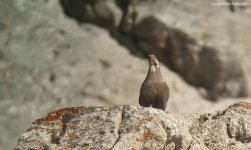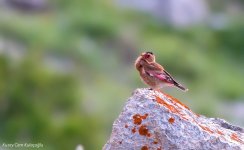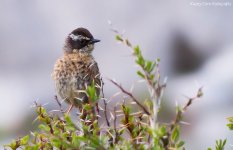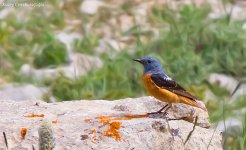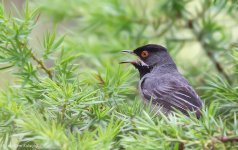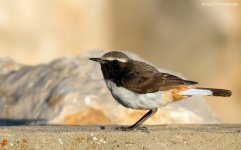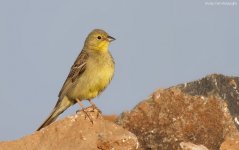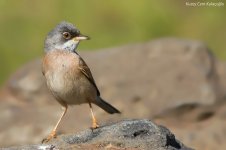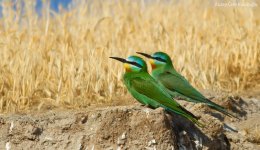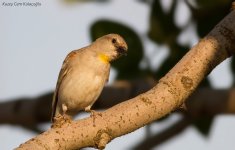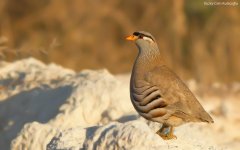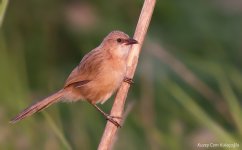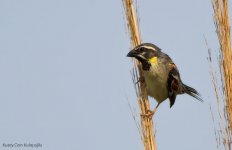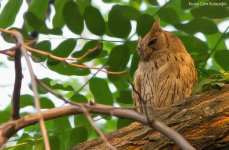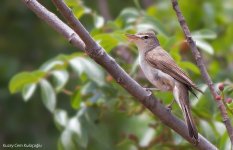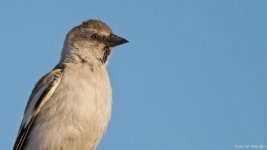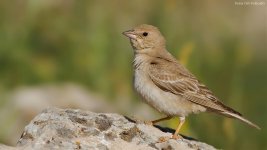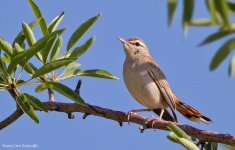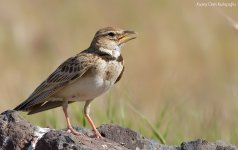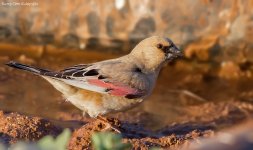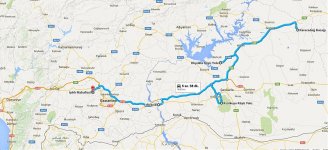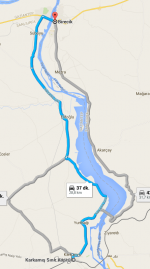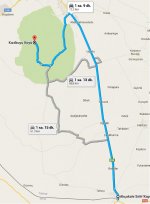kuzeycem
Medicinal Birding

Two weeks ago I took a 5-day long birdwatching trip that spread over a large area in southern Turkey. I started from Aladağlar mountains in south-central Turkey, and then passed on to southeast Turkey where I visited places like Nemrut mountain, Kızılkuyu plains, Karacadağ mountain, Birecik (Euphrates) and Işıklı village.
As I've never been to those parts of Turkey before (despite being a Turk myself), I felt the need of a guide, and thus throughout our trip I was accompanied by Emin Yoğurtcuoğlu who is a Turkish wildlife guide with a record number of species seen in Turkey (http://www.sunbirdtours.co.uk/leaders/emin-yogurtcuoglu/).
As the we visited quite a lot of places in a long time period, I have decided to split this report into 4 parts. This post is the first. Others will follow shortly on this page.
Part 1: Demirkazık Mountain - Aladağlar National Park, Çamardı, Niğde
Emin and I left Ankara at 11:00 AM and went straight to Çamardı, Niğde. We only took a very short break, thus the trip only lasted for about 6 hours. Once we were there, there was still sufficient sunlight left and thus we decided to head up to a place called Arpacık gorge on Demirkazık mountain. Demirkazık is a pretty high mountain standing at 3.756 meters, however the gorge is only about c.2500 meters and is relatively easily accessible by car. There are several camps for mountain climbers just before it. Normally most birdwatchers visiting Aladağlar would go to the miners' road, which is around 3300m, but it was apparently closed by a large rock. Nonetheless, the gorge was quite productive despite the rapidly setting sun. The first birds we saw were those that we flushed while ascending to the gorge with the car, such as Horned Lark and White-winged Snowfinch (which were oddly shy). Once we arrived at the spot we were greeted by a small group of Red-fronted Serins which were quite tame as expected (bad light though for photography though). The air was largely dominated by Common House Martins, but every now and then a small group of Alpine Choughs would soar by, and around the cliff flocks of Red-billed Choughs were abundant. Eurasian Crag Martins also bred around a cave nearby.
After a while we started ascending on foot to a spot for the legendary snowcock. When we reached there it didn't take a minute for us to hear it. But finding it was a whole another thing. It was quite challenging as it kept moving and it didn't take long for us to figure out that there were actually two birds. Meanwhile, classic birds like snowfinch and Rock Buntings were foraging, and at one point an Alpine Accentor landed on a rock not too far away.
After 30 minutes of desperate searching, we finally found the Caspian Snowcock high up in the cliffs. It was a magnificent sight to see it extend it's neck and call out, while moving slightly and occasionally flying from cliff to cliff. At one point it was even harassed by a group of Red-billed Choughs! After a while it got bored of us and flew all the way back to the other side of the mountain.
As the sun was going down, we started to descend. But on the way down we stumbled upon a Eurasian Crimson-winged Finch perched on a boulder and a Radde's Accentor move around in some bushes, respectively. A nice way to end the day!
We stayed at the infamous Safak Pension. The foods were great and accommodation was nice overall. Had a good dinner and slept rather early.
10 June:
I woke up at 08:00 AM and took a quick stroll around the pension garden. European Blue Tits, European Greenfinch and Black-headed Buntings were plenty. After a while Emin woke up too. We had breakfast at 8:30 and went back to the mountains shortly after. This time we went to a more deserted area, about 2300 meters high. Birds like White-winged Snowfinch, Red-fronted Serin and Rock Bunting were seen again. In addition we had several male White-throated Robins and Black Redstarts. There were also lots of Asia Minor Ground Squirrels. We slowly arrived at a place where we searched for Ring Ouzel. We failed to find any, but found a nice male Common Rock Thrush, as well as a Chukar Partridge and another Eurasian Crimson-winged Finch. Also Northern, Isabelline & Finsch's Wheatears.
From there we went back to the pension, packed our stuff and hit the road. On the way we stopped at somewhere at Adana to eat, and we quickly found a male Rüppell's Warbler at the garden.
After that we headed straight to Nemrut mountain at Kahta, Adıyaman. There we stayed at Karadut Pension, which was quite nice.
More on part 2.
As I've never been to those parts of Turkey before (despite being a Turk myself), I felt the need of a guide, and thus throughout our trip I was accompanied by Emin Yoğurtcuoğlu who is a Turkish wildlife guide with a record number of species seen in Turkey (http://www.sunbirdtours.co.uk/leaders/emin-yogurtcuoglu/).
As the we visited quite a lot of places in a long time period, I have decided to split this report into 4 parts. This post is the first. Others will follow shortly on this page.
Part 1: Demirkazık Mountain - Aladağlar National Park, Çamardı, Niğde
Emin and I left Ankara at 11:00 AM and went straight to Çamardı, Niğde. We only took a very short break, thus the trip only lasted for about 6 hours. Once we were there, there was still sufficient sunlight left and thus we decided to head up to a place called Arpacık gorge on Demirkazık mountain. Demirkazık is a pretty high mountain standing at 3.756 meters, however the gorge is only about c.2500 meters and is relatively easily accessible by car. There are several camps for mountain climbers just before it. Normally most birdwatchers visiting Aladağlar would go to the miners' road, which is around 3300m, but it was apparently closed by a large rock. Nonetheless, the gorge was quite productive despite the rapidly setting sun. The first birds we saw were those that we flushed while ascending to the gorge with the car, such as Horned Lark and White-winged Snowfinch (which were oddly shy). Once we arrived at the spot we were greeted by a small group of Red-fronted Serins which were quite tame as expected (bad light though for photography though). The air was largely dominated by Common House Martins, but every now and then a small group of Alpine Choughs would soar by, and around the cliff flocks of Red-billed Choughs were abundant. Eurasian Crag Martins also bred around a cave nearby.
After a while we started ascending on foot to a spot for the legendary snowcock. When we reached there it didn't take a minute for us to hear it. But finding it was a whole another thing. It was quite challenging as it kept moving and it didn't take long for us to figure out that there were actually two birds. Meanwhile, classic birds like snowfinch and Rock Buntings were foraging, and at one point an Alpine Accentor landed on a rock not too far away.
After 30 minutes of desperate searching, we finally found the Caspian Snowcock high up in the cliffs. It was a magnificent sight to see it extend it's neck and call out, while moving slightly and occasionally flying from cliff to cliff. At one point it was even harassed by a group of Red-billed Choughs! After a while it got bored of us and flew all the way back to the other side of the mountain.
As the sun was going down, we started to descend. But on the way down we stumbled upon a Eurasian Crimson-winged Finch perched on a boulder and a Radde's Accentor move around in some bushes, respectively. A nice way to end the day!
We stayed at the infamous Safak Pension. The foods were great and accommodation was nice overall. Had a good dinner and slept rather early.
10 June:
I woke up at 08:00 AM and took a quick stroll around the pension garden. European Blue Tits, European Greenfinch and Black-headed Buntings were plenty. After a while Emin woke up too. We had breakfast at 8:30 and went back to the mountains shortly after. This time we went to a more deserted area, about 2300 meters high. Birds like White-winged Snowfinch, Red-fronted Serin and Rock Bunting were seen again. In addition we had several male White-throated Robins and Black Redstarts. There were also lots of Asia Minor Ground Squirrels. We slowly arrived at a place where we searched for Ring Ouzel. We failed to find any, but found a nice male Common Rock Thrush, as well as a Chukar Partridge and another Eurasian Crimson-winged Finch. Also Northern, Isabelline & Finsch's Wheatears.
From there we went back to the pension, packed our stuff and hit the road. On the way we stopped at somewhere at Adana to eat, and we quickly found a male Rüppell's Warbler at the garden.
After that we headed straight to Nemrut mountain at Kahta, Adıyaman. There we stayed at Karadut Pension, which was quite nice.
More on part 2.
Attachments
Last edited:




